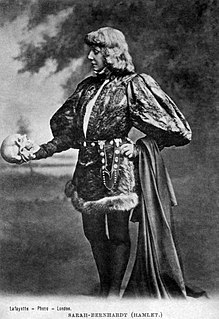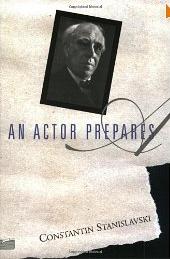
Acting is an activity in which a story is told by means of its enactment by an actor or actress who adopts a character—in theatre, television, film, radio, or any other medium that makes use of the mimetic mode.

Method acting is a range of training and rehearsal techniques that seek to encourage sincere and emotionally expressive performances, as formulated by a number of different theatre practitioners. These techniques are built on Stanislavski's system, developed by the Russian actor and director Konstantin Stanislavski and captured in his books An Actor Prepares, Building a Character, and Creating a Role.

The Seagull is a play by Russian dramatist Anton Chekhov, written in 1895 and first produced in 1896. The Seagull is generally considered to be the first of his four major plays. It dramatises the romantic and artistic conflicts between four characters: the famous middlebrow story writer Boris Trigorin, the ingenue Nina, the fading actress Irina Arkadina, and her son the symbolist playwright Konstantin Tréplev.

Epic theatre is a theatrical movement arising in the early to mid-20th century from the theories and practice of a number of theatre practitioners who responded to the political climate of the time through the creation of a new political theatre. Epic theatre is not meant to refer to the scale or the scope of the work, but rather to the form that it takes. Epic theatre emphasizes the audience's perspective and reaction to the piece through a variety of techniques that deliberately cause them to individually engage in a different way. The purpose of epic theatre is not to encourage an audience to suspend their disbelief, but rather to force them to think introspectively about the particular moments that are occurring on stage and why they are happening a certain way.

Stanislavski's system is a systematic approach to training actors that the Russian theatre practitioner Konstantin Stanislavski developed in the first half of the 20th century. Stanislavski was the first in the West to propose that actor training should involve something more than merely physical and vocal training. His system cultivates what he calls the "art of experiencing". It mobilises the actor's conscious thought and will in order to activate other, less-controllable psychological processes—such as emotional experience and subconscious behaviour—sympathetically and indirectly. In rehearsal, the actor searches for inner motives to justify action and the definition of what the character seeks to achieve at any given moment.

In acting, units of action, otherwise known as bits or beats, are sections that a play's action can be divided into for the purposes of dramatic exploration in rehearsal.

Mikhail Aleksandrovich "Michael" Chekhov was a Russian-American actor, director, author and theatre practitioner. He was a nephew of the playwright Anton Chekhov and a student of Konstantin Stanislavski. Stanislavski referred to him as his most brilliant student.

Mikhail Semyonovich Shchepkin was the most famous Russian Empire actor of the 19th century. He is considered the "father" of realist acting in Russia and, via the influence of his student, Glikeriya Fedotova, a major influence on the development of the 'system' of Konstantin Stanislavski. Shchepkin's significance to the Theatre of Russia is comparable to that of David Garrick to the English theatre.

The Moscow Art Theatre is a theatre company in Moscow. It was founded in 1898 by the seminal Russian theatre practitioner Konstantin Stanislavski, together with the playwright and director Vladimir Nemirovich-Danchenko. It was conceived as a venue for naturalistic theatre, in contrast to the melodramas that were Russia's dominant form of theatre at the time. The theatre, the first to regularly put on shows implementing Stanislavski's system, proved hugely influential in the acting world and in the development of modern American theatre and drama.

An Actor Prepares is the first of Konstantin Stanislavski's books on acting, followed by Building a Character and Creating a Role. Stanislavski intended to publish the contents of An Actor Prepares and Building a Character as a single volume, and in the Russian language. However, An Actor Prepares was first published as a single volume in English, and World War II delayed the publication of Building a Character for more than ten years.
Psychotechnique forms part of the 'system' of actor training, preparation, and rehearsal developed by the Russian theatre practitioner Konstantin Stanislavski. It describes the inner, psychological elements of training that support what he called "experiencing" a role in performance. In a rehearsal process, psychotechnique is interrelated with the "embodiment" of the role, in order to achieve a fully realised characterisation. Stanislavski describes the elements of psychotechnique in the first part of his manual An Actor's Work.

Realism in the theatre was a general movement that began in the 19th-century theatre, around the 1870s, and remained present through much of the 20th century. It developed a set of dramatic and theatrical conventions with the aim of bringing a greater fidelity of real life to texts and performances. Part of a broader artistic movement, it includes Naturalism and Socialist realism.

The "art of representation" is a critical term used by the seminal Russian theatre practitioner Konstantin Stanislavski to describe a method of acting. It comes from his acting manual An Actor Prepares (1936). Stanislavski defines his own approach to acting as "experiencing the role" and contrasts it with the "art of representation". It is on the basis of this formulation that the American Method acting teacher Uta Hagen defines her recommended Stanislavskian approach as 'presentational' acting, as opposed to 'representational' acting. This use, however, directly contradicts mainstream critical use of these terms. Despite the distinction, Stanislavskian theatre, in which actors 'experience' their roles, remains 'representational' in the broader critical sense.

The Moscow Art Theatre production of Hamlet in 1911–12, on which two of the 20th century's most influential theatre practitioners—Konstantin Stanislavski and Edward Gordon Craig—collaborated, is particularly important in the history of performances of Hamlet and of 20th-century theatre in general.

The Moscow Art Theatre production of The Seagull in 1898, directed by Konstantin Stanislavski and Vladimir Nemirovich-Danchenko, was a crucial milestone for the fledgling theatre company that has been described as "one of the greatest events in the history of Russian theatre and one of the greatest new developments in the history of world drama." It was the first production in Moscow of Anton Chekhov's The Seagull, though the play had been performed with only moderate success in St. Petersburg two years earlier. Nemirovich, who was a friend of Chekhov's, overcame the writer's refusal to allow the play to appear in Moscow after its earlier lacklustre reception and convinced Stanislavski to direct the play for their innovative and newly founded Moscow Art Theatre (MAT). The production opened on 29 December [O.S. 17 December] 1898. The MAT's success was due to the fidelity of its delicate representation of everyday life, its intimate, ensemble playing, and the resonance of its mood of despondent uncertainty with the psychological disposition of the Russian intelligentsia of the time. To commemorate this historic production, which gave the MAT its sense of identity, the company to this day bears the seagull as its emblem.
Ioasaf Aleksandrovich Tikhomirov (1872-1908) was a Russian actor. He trained under Vladimir Nemirovich-Danchenko, who offered "rigorous and intelligent" courses in actor training at the school of the Moscow Philharmonic Society. Tikhomirov was one of twelve students that Nemirovich brought with him to join the Moscow Art Theatre when he founded it with Constantin Stanislavski in 1898. He acted with the company until 1904 and also served as the director of the Art Theatre School. In 1904 Stanislavski sent Tikhomirov to help Maxim Gorky to establish his newly founded theatre in Nizhny Novgorod, but the project was abandoned when the Russian censor banned every play that they proposed to stage.
The term Given Circumstances is a principle from Russian theatre practitioner Konstantin Stanislavski's methodology for actor training, formulated in the first half of the 20th century at the Moscow Art Theatre.
Classical acting is a type of acting that is based on the theories and systems of select classical actors including Konstantin Stanislavski and Michel Saint-Denis, including the expression of the body, voice, imagination, personalizing, improvisation, external stimuli, and script analysis.
Sonia Moore was a Russian-born American actress, writer and acting teacher. She is known for simplifying Stanislavski's system of acting devised by Konstantin Stanislavski. Moore was a student of Yevgeny Vakhtangov, and later became an acting teacher.















